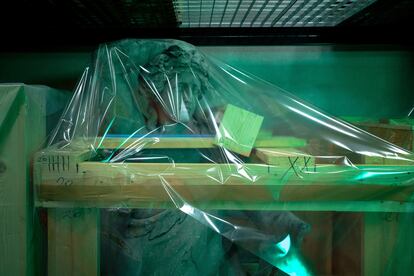How to protect the world’s art treasures from climate change
Many techniques and strategies are being put in place to protect large museums and collections from the hazards of global warming

Sometimes it seems like the world is flooding. Other times, it’s on fire. This has been seen from Rhodes and Corfu (Greece) to Palermo and Messina (Italy) and Cascais (Portugal) or Quebec (Canada). The ground burns and, as the mercury rises, the heat puts the world’s artistic heritage in a bind. The climate emergency is descending into Dante’s inferno. In Spain, the Prado and the Reina Sofía museums are a great cause of concern. The latter is more threatened by water than by flames; a stream flows underground, and explosive cyclogeneses are unpredictable. The former has a security protocol that is not public. Some paintings are geolocated with chips. But not many; the technology is expensive.
The Reina Sofía — explains restorer Manuela Gómez — writes its rules on the granite of its walls. The temperature in the exhibition areas is 20 degrees Celsius (68 Fahrenheit). A variation of ±2 is allowed. The margin is identical for humidity (50%). They have been working on a security plan for years: the rooms will have personal protective equipment (similar to that used by healthcare workers during the pandemic) and fire blankets. In addition, there will be a digital alarm system linked to the fire department; a screen will show them the problem and its location, so they can put together a strategy without delay. Because the difference between a Picasso being preserved or being destroyed can be a matter of minutes. Even seconds.
The past has put the present of art on alert. The historic Hurricane Sandy, which flooded New York in 2012, fell from the sky like an omen. “Art storage facilities have been removed from flood risk areas,” explains curator Gabriel Pérez-Barreiro. Storage giants — like UOVO, which has 10 locations in the United States — are protecting themselves from a potential disaster. Its warehouses located in risky places, like the one in the Wynwood neighborhood in Miami, are built 18 feet above sea level and can withstand a category 5 hurricane (with winds of up to 70 miles per hour).
To protect itself from possible flooding, in 2024 the Louvre will move 250,000 works to its conservation center in the commune of Liévin, in the north of France, one hour from Paris by high-speed train. This might be, they say, the largest movement of pieces of art in history. It was necessary: the banks of the Seine, where the museum is located, are very vulnerable to flooding. Some of its galleries and storage rooms are practically under the river, so a flood would put hundreds of works at risk. Only an irresponsible person would jeopardize their Caravaggios, Leonardos or Goyas.
Back in the U.S., despite the fact that flames already surrounded the Getty Center, in California, in October 2019, trust is the main prevention system. The Center is confident that its building (built with marble and cement and protected by steel) is capable of withstanding fire; even its extensive green area, with systematically pruned oak trees, would act as a retardant if a fire breaks out, the institution maintains. Nobody wants to lose their assets. The Helen Frankenthaler Foundation, in New York, has created the most ambitious private program in the country’s artistic history (with a budget of $10 million) to confront — through subsidies — the climate crisis. The Museum of Modern Art in New York (MoMA) is designing a cold storage vault. The Philadelphia Museum of Art is building something unprecedented: a floating gallery on a barge on the Delaware River. And the Museum of Contemporary Art in Los Angeles, is tapping into funds from the Frankenthaler Climate Initiative. Who wants to slow dance in a burning room?
Sign up for our weekly newsletter to get more English-language news coverage from EL PAÍS USA Edition
Tu suscripción se está usando en otro dispositivo
¿Quieres añadir otro usuario a tu suscripción?
Si continúas leyendo en este dispositivo, no se podrá leer en el otro.
FlechaTu suscripción se está usando en otro dispositivo y solo puedes acceder a EL PAÍS desde un dispositivo a la vez.
Si quieres compartir tu cuenta, cambia tu suscripción a la modalidad Premium, así podrás añadir otro usuario. Cada uno accederá con su propia cuenta de email, lo que os permitirá personalizar vuestra experiencia en EL PAÍS.
¿Tienes una suscripción de empresa? Accede aquí para contratar más cuentas.
En el caso de no saber quién está usando tu cuenta, te recomendamos cambiar tu contraseña aquí.
Si decides continuar compartiendo tu cuenta, este mensaje se mostrará en tu dispositivo y en el de la otra persona que está usando tu cuenta de forma indefinida, afectando a tu experiencia de lectura. Puedes consultar aquí los términos y condiciones de la suscripción digital.
More information
Archived In
Últimas noticias
David Bowie, the galactic thinker who encouraged us to break new ground
John Berger and the loss of rural culture
From police officer to bloodthirsty kidnapper: Terror in Mexico during the years of ‘The Ear Chopper’
Alain Aspect, Nobel laureate in physics: ‘Einstein was so smart that he would have had to recognize quantum entanglement’
Most viewed
- David King, chemist: ‘There are scientists studying how to cool the planet; nobody should stop these experiments from happening’
- Reinhard Genzel, Nobel laureate in physics: ‘One-minute videos will never give you the truth’
- Oona Chaplin: ‘I told James Cameron that I was living in a treehouse and starting a permaculture project with a friend’
- Mexico completes its trade shift with the entry into force of tariffs on China and countries without trade agreements
- Sinaloa Cartel war is taking its toll on Los Chapitos











































